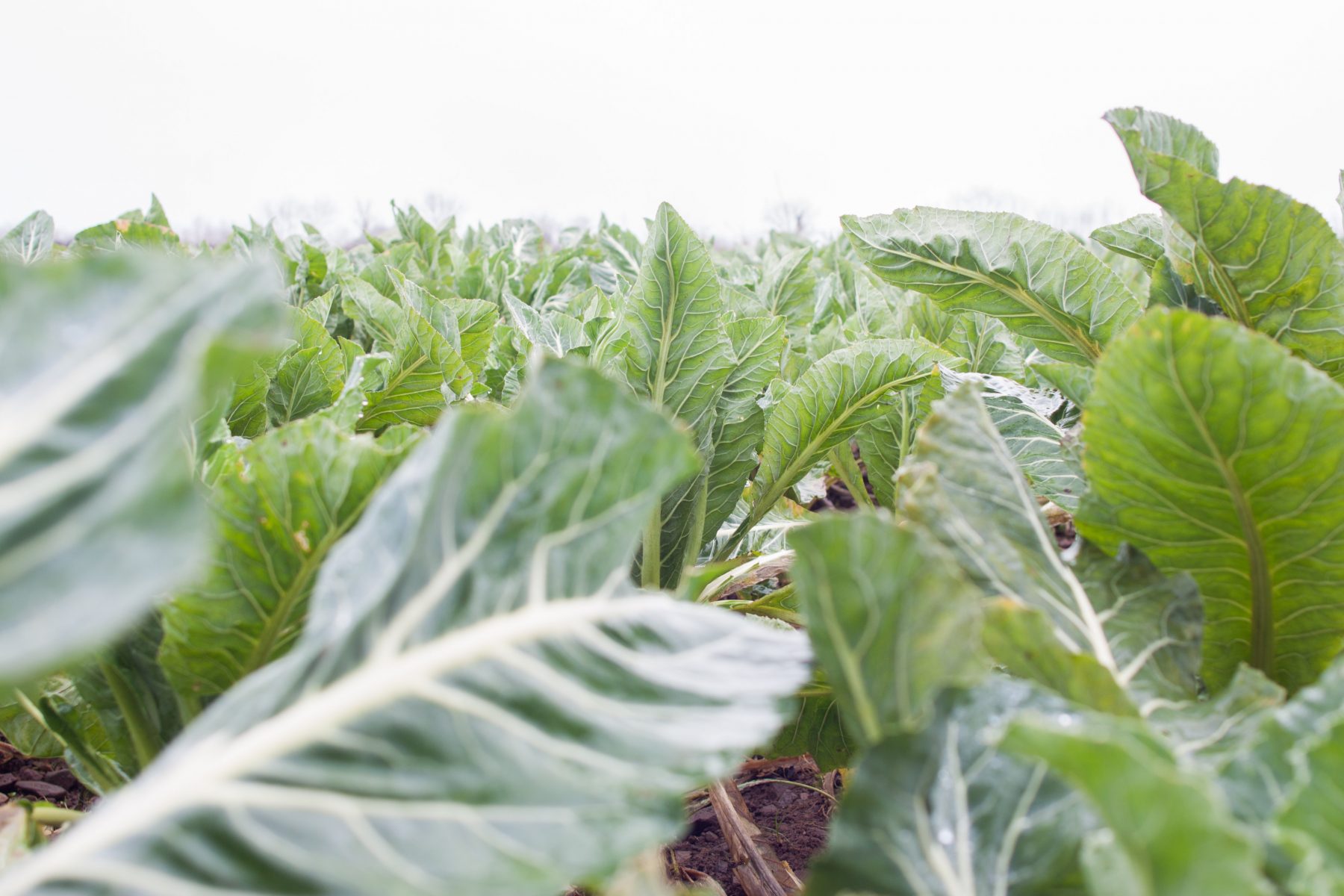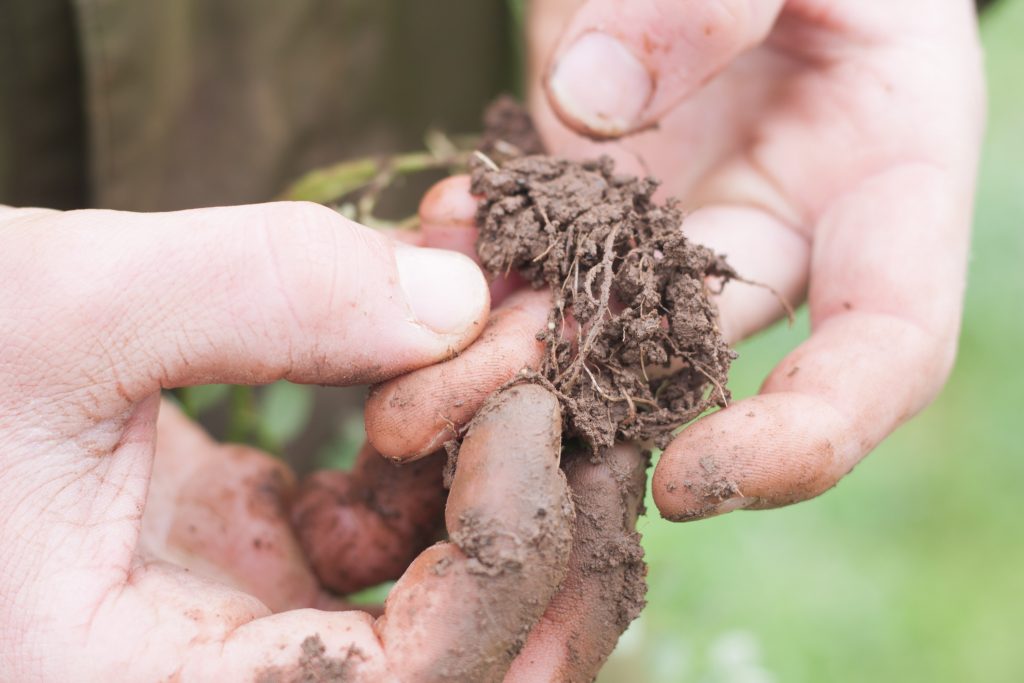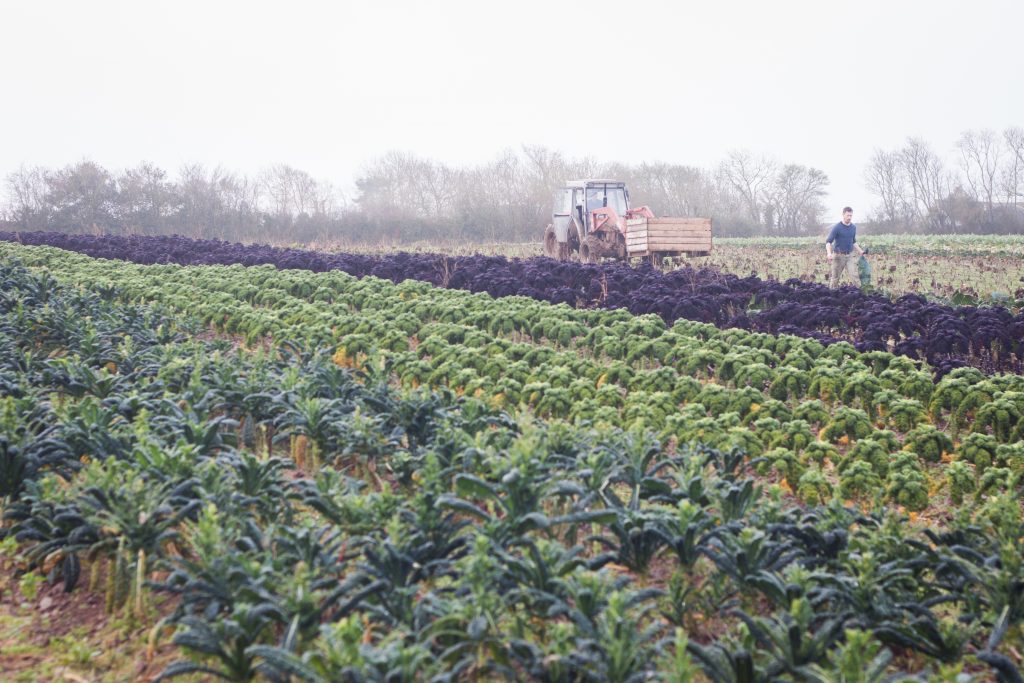This post has been reposted from The Locavore website with permission:
I’ve been to a LOT of vegetable farms over the past five years. However, occasionally one comes along that sparks my interest and inspires me to find out more. I heard about Plowright Organic last year and was intrigued; partly because they’re growing on 30 acres of land and use some machinery on the land. But what got me most interested was the fact that they provide totally farm grown veg boxes for nine months of the year; something that few farms in this country can achieve. Time for a visit I think…
Started back in 2000 by Richard and Remke, ten years ago Plowright Organic moved to Stowey Rocks Farm at the foot of the Quantock Hills in West Somerset. It’s a rather grey Monday morning when I take a farm walk with Adam, one of the growers, and the hills are masked in a slightly etherial blanket of mist. “It’s an 80 acre organic holding rented from the council, originally on a 7 year tenancy but we’ve just renewed for another five years.” he explains as we set out across the farmyard. “The tenancy beyond 2021 is far from certain, and this is a real issue but Richard is always optimistic about the future and continues to invest in the business.” Security of tenure represents a challenge for many farmers, but Plowright are remaining positive despite the uncertainty.
Adam continues; “We currently crop on about 30 acres out of the 80, and the rest is either permanent pasture, woodland, hedgerows or leys.” As we walk past we pop into the small farm shop that operates on an honesty box basis, the vegetables all laid out in boxes ready for people to help themselves to; “It’s fantastic; we have about forty or fifty people coming here over the course of the 3 days that it’s open.” As I look around the shop and the wide range of veg on offer, we talk about their other routes to market. As well as the shop, they have a veg box operation. “We deliver from Bristol right down to Taunton and across to Wellington; a lot of it is to villages which is quite rare, and it’s nice to be able to provide the rural areas with veg boxes.” They average around 220 boxes a week, but the most unusual thing about Plowright though is that their boxes are 100% farm grown for nine months of the year; a remarkable thing when compared to most operations that buy in heavily during winter and spring. They also sell a lot wholesale, some to local community shops but also to places like The Community Farm and Green Wheel to help support their box schemes.
There are four of them working full time on the land, two people doing grading and packing of the boxes, two drivers, and one person doing a lot of the behind the scenes work including managing the orders and paperwork. We wander into the packing shed, where trays of freshly harvested cabbages are waiting at the entrance, but as it’s a Monday morning most of the crates pallets are stacked up along the side waiting for harvesting to get underway later in the week. “In the summer we usually harvest as much as we can before the sun’s out and get it in the chiller straight away,” he explains. “We’ll often harvest roots the week before too to take the pressure off.” He also explains that they try and time the harvesting around the weather to look after the soil but also to try to avoid having to wash the vegetables, which keeps them fresher. Their walk-in cooler still contains carrots, parsnips and potatoes, despite it being the end of January, and they’re looking to build new chiller this year that will allow them to harvest crops earlier and get cover crops in the ground, as well as improve storage for crops through the hungry gap (the period from March – June where there are few vegetables growing in the fields).
The next stop on the tour is the tractor shed. Conversation turns to the controversy of mechanisation in organic farming, but Plowright have opted to use tractors and machinery in well timed and carefully thought out ways. With it being winter, everything is mostly packed away at the moment, but Adam takes me round and shows me the different implements “We do everything on a bed system so the whole production system is standardised. It’s a 1.2m bed and everything’s on 3 rows,” he explains. He shows me the drill they use for seeding, reducing the need for labour intensive tasks like thinning out, the one man weeding machine (“One person can go out on a summers evening and do 10 acres!”) and the carousel planter that allows you to change the spacing between plants, and you just load the plugs from trays into the machine. We pause by the bed former, where Adam explains why it’s an important piece of machinery for them. “It’s got a hydraulic compressor on the back which allows us to set the compression of the beds for different crops, though we usually only have it set to one compression. It’s also what creates the raised bed system we use, which helps create better drainage, increases warmth in the soil and also buries stones”.
He explains that each piece of machinery has it’s individual use, and helps reduce the manual labour input, one of the biggest costs to organic farmers. One of the key tools in this is the steerage hoe, which represents their primary weeding method. An assortment of blades and rakes protrude rather fearsomely from the implement, allowing you to set each one precisely to your needs. The other key aspect is in the name; “It has hydraulic steering so you just tap it left and right and steer it; you can take it really close to the plant,” he points out. Another important implement is the gas burner. “It’s monstrous, but it’s super efficient,” Adam tells me with a laugh as I stare in amazement at the size of the hulking device. “We only use it on drilled crops; we do a strike before we drill and then we do a pre-emergent strike so it gives the carrots or parsnips a little bit extra time to get ahead of the weeds.”
The tractor tour complete, we head out to the fields and begin to walk the perimeter of the farm. It may be the end of January but there’s a surprising amount still in the ground, and as we walk Adam talks me through what’s still growing and what was there earlier in the season. “We have everything set into blocks and each block is about two acres, so you can see the lineages around the farm.” There’s almost no bare soil in the fields, and we stop to look at one of the winter cover crops that helps protect the soil. “This is rye and vetch that we sowed in September; you’ll see this all around the farm,” he shows me. “And you’ll notice that we have a lot of weeds on the farm,” he points out with a smile. “Richard has a good philosophy about them; we really like them. They’re fantastic soil protectors for the crops we can’t get a green manure into at the right time and create such diversity within the soil.” He stops and looks out across the field for a moment. “We try to manage weeds at the right time; it’s really important to manage them during the early growth. Once you get a plant above that stage it can compete for itself.” As we continue around the fields, he tells me about a botanist who comes to do surveys twice a year and told them they have a lot of species you don’t see in the farm landscape any longer. It’s clearly of benefit to the biodiversity on the farm as well, as the amount of birds and bugs flying around are testament to. “We try let some things go to flower too; the bees will love it.”
We crouch down to look at the soil; it’s a sandy loam with good drainage. Adam digs up a vetch plant to point out the nodules on the roots; “That’s the nitrogen bacteria (Rhizobium) that fixes the nitrogen that is made available when the plant decays,” he explains. “The soil is just so friable (a good crumbly texture) and it has a really high level of organic matter,” he continues, showing me the root systems from the weeds. A worm comes into sight and conversation turns to them. “The worm count here is fantastic!” he says proudly, before showing me the worm castings all over the surface and explaining a few of the different types of worms we could see.
Our route takes us past a patch of woodland. “This is Stowey Wood,” Adam tells me as we peer through the trees. “It’s part of the farm but the council manage it; it’s an old plantation and they’re currently felling it and replanting with deciduous native trees. All of a sudden there’s so many flowers and plants!” We walk along the edge of the woods for a few minutes and into their overwintering brassica field, currently sporting the promising beginnings of a purple sprouting broccoli crop. We spend a few minutes watching the pigeons swooping down to enjoy a snack from some of the exposed plants before moving into the next field. “You cut your losses and you can’t get too angry at the pigeons,” he says with a good natured smile before stopping to highlight the size of their hedgerows and margins; “That’s 6 or 7 meters there! We get high winds here, so Richard and Remke have allowed the hedges to be as big as possible.”
Across the sea of kale, sprouts and cauliflower, two of the other growers Owen and Joel are busy harvesting cabbages and we stop to wave. With a tractor in sight, conversation touches again on the mechanisation of the farm; “I think the middle ground between no-dig and conventional tillage is the permanent bed systems and I really think it’s got a future,” Adam comments. “Richard’s developed a very good philosophy regarding mechanisation and cares deeply about it. We do use tractors and machinery, but if you do it at the right time you can make it work; you can build soil health, soil structure, increase worm counts…”
Pausing for a moment to look over the rolling hills, a small brook and patch of woodland, Adam points out the perimeter of the farm. “Our neighbour next door is an organic farmer and he grazes his sheep and cattle on some of our pasture in exchange for manure, which is good for us,” he explains. On the other side is a large empty field. “This year we lost something like 60,000 leeks in that field to wireworm,” he tells me. “It shows how precarious farms are. There’s so much risk in farming; this could have put a farm out of business; one simple crop loss.”
Looping back towards the centre of the farm, we stop by the tunnels, and Adam is in his element; “I run the indoor cropping; I’m learning a lot from it!” he says with a grin. He’s only been growing for four years, and I ask how he got interested in it. “When I was at university I took a year out to work in industry, and got involved in this community garden behind the university. I found that so many issues can be solved by a local seasonal diet. And it’s just such a nice thing to do!” His hard work has paid off and the tunnels are bursting with life; spinach, herbs, chinese cabbage, pak choi and much more. “These are permanent beds, so minimum tillage. We broad fork at the moment, but the idea is that we move away from that. We’re trying to mound up and create raise beds to reduce the foot traffic. We put compost on top, disturb the soil as little as possible, and you can get your hand so deep in!” he says, demonstrating by sinking his hand deep into the bed. We look into the next tunnel, full of the remnants of winter salad, and a third tunnel which is being prepped for the early crops. “This will be early carrots, courgettes, baby leaf kale, some alliums, some beetroot. We dig the beds by hand and use a rake to create a nice tilth that we can drill into. The benefit of the hand drilling is that instead of having the three rows we have in the field, we can get four rows in here, so we can increase the amount of food grown on one area of land. But it takes more time, so we just try and find the balance.”
As we leave he points out some of the giant sunflowers that are all over the farm. “I love sunflowers!” he explains with a wide grin. “And it really helps the birds who then eat the pests,” he points out. “I do a lot of flowers in the tunnels during the summer too, just to try and encourage insects in and create a better environment.” The last part of our walk takes us through the orchard, where there trees are bare and the ground is littered with the last few windfalls. “There’s about 200 trees and 15 varieties,” Adam tells me. “The birds love this place; we have a flock of fieldfare who spend a lot of time here.”
We find ourselves back at the start and fortuitously in perfect time for the coffee break. Everyone gathers in the farmhouse kitchen, coffee is brewed, jars of peanut butter are cracked open and everyone sits down for a half hour. The team here works hard, but as I look around the room I see a group of people who enjoy and care about what they do. And with that, I take a sip of my tea.
FIND OUT MORE: https://plowrightorganic.co.uk














